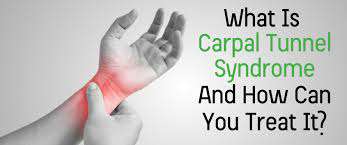
Carpal Tunnel Syndrome (CTS) is a condition that affects a patient’s quality of life. About three to six percent of the adult population in the United States suffers from carpal tunnel. Some cases of CTS will improve by themselves, but many require medical intervention. Sadly, many modern-day medical treatments only provide short-term relief for patients. They do not solve the underlying problem that causes CTS.
Platelet-Rich Plasma is a proven regenerative medicine treatment that is beginning to show promise as a treatment for carpal tunnel syndrome. But first, it may be helpful to understand what CTS is and why it occurs.
What Is Carpal Tunnel Syndrome?
Carpal Tunnel Syndrome is a medical condition that originates in the wrist’s carpal tunnel. The condition causes a variety of symptoms including, but not limited to:
- The loss of feeling in a patient’s hand or hands
- A loss of grip strength from loss of thumb muscles
- Pain in the wrists and hands
This condition can cause blue-collar workers who perform heavy manual labor to retire or seek another occupation. Office workers who sit at their desk for long periods of time can also experience great pain from this condition, which can prevent them from performing their job.
What Causes Carpal Tunnel Syndrome?
Carpal tunnel occurs when there is pressure on the median nerve in a patient’s wrist. The pressure on the median nerve can come from a variety of sources.
Diseases Such As, Thyroid Dysfunction, Diabetes, High Blood Pressure, and Autoimmune Disorders
A side effect of many diseases is carpal tunnel syndrome. Many diseases and conditions cause inflammation throughout the body. It is no surprise that the additional inflammation leads to more pressure on the median nerve.
Fluid Retention From Pregnancy or Menopause
Carpal tunnel syndrome is a common condition during pregnancy or menopause. The additional fluid retention that the body keeps will place pressure on the median nerve. This can cause great pain and discomfort to women, which is difficult to treat. The good news is that once the pregnancy or menopause is over, the condition should improve.
Physical Injury
Many office workers and blue-collar workers will deal with this condition from their work. The repetitive motion can cause ligaments in the wrist to become damaged and create scar tissue that puts additional pressure on the median nerve. A freak physical injury can also shift the body, so that there is massive pressure on the median nerve.
Current Treatment Methods
There are a few treatment methods that are currently used to combat carpal tunnel syndrome.
Wrist Splints
One of the most common first treatments that a doctor will recommend are wrist splints. These splints will help keep your wrists in the correct position in order to alleviate pain and prevent further damage. Many patients wear wrist splints at night, which help relieve symptoms during the day. There is not much evidence that wrist splints work in the long term. Patients are encouraged to use this form of treatment until their condition worsens.
Anti-Inflammatory Drugs
Another treatment method that is often used is anti-inflammatory drugs, such as Advil. These types of medications are great for relieving pain in the short term, but they do not solve the underlying problem of the condition. These drugs will only provide pain relief. Over time a patient’s condition will continue to worsen.
Corticosteroids
Corticosteriods are an injection that your doctor will administer to the affected area. These injections reduce inflammation and swelling, which will reduce the pressure on the nerves. This treatment is again great for the short term, but does not solve the underlying condition of carpal tunnel syndrome. In one study, 63% of patients who received corticosteroid injections had to have surgery eventually.
Surgery
Typically, the last resort that a patient will turn to is surgery. There are a few varieties of surgeries, but they typically involve cutting the ligaments in your wrist to free the nerve. The road to recovery from carpal tunnel surgery is typically long. It may take patients at least three months to fully recover from surgery. Additionally, surgery may not relieve a patient’s symptoms long term.
In one study, only 14% of patients who received the surgery were symptom free after four years. That is a staggering low number for a surgical procedure. Even worse, 46% had moderate to severe pain, 52% had moderate to severe numbness, and 40% had difficulty grasping and using small objects.
Thankfully, a form of regenerative medicine has shown great promise in treating patients with carpal tunnel syndrome.
PRP For Patients With Carpal Tunnel
Platelet-Rich Plasma (PRP) is a proven regenerative medicine therapy that can treat a variety of diseases and conditions. There is a good amount of evidence that indicates PRP can be a viable treatment for CTS. PRP is used in several disciplines to improve a patient’s quality of life. PRP actually utilizes the body’s own natural healing abilities to repair itself.
Blood is drawn from the patient and spun through a centrifuge, which separates the powerful healing platelets from the rest of the blood. Additional growth and healing factors are typically added to the platelets to further promote healing. The plasma is then injected into the affected area. The platelets and growth factors will facilitate the body to repair the damaged tissue at the injection site.
PRP can repair the underlying condition that is causing CTS. Your body can repair the tissue and ligaments that are placing pressure on the median nerve. Once your body repairs these damaged areas, the median nerve will be free to function as before the condition took hold.
The evidence of PRP being an effective form of treatment for carpal tunnel syndrome is growing. Researchers are creating more studies that are looking at the effectiveness of PRP for patients with CTS. The hope is that PRP will be a standard treatment for CTS one day.
Studies Are Showing The Effectiveness of PRP For CTS
A number of studies have shown that PRP is an effective therapy for patients with CTS.
Small, But Promising Study
A small study involving 14 patients has shown just how effective PRP can be for patients with CTS. The typical PRP treatment process was used in this study. They received the treatment around the median nerve in the afflicted wrist. Patients were encouraged to resume their daily activities after they received the treatment.
Eight patients had a full or nearly full recovery after a month. Three patients had a significant improvement in their condition. The last three patients only had a fair recovery from their condition. For the improved patients the disabilities of the arm, shoulder, and hand showed that upper limb function greatly after the therapy. After three months, the patients’ conditions had more or less stayed the same.
The patients reported no side effects. There was no additional pain or injections from the treatment. It should be noted that no additional growth or healing factors were added to the PRP after the platelets were separated from the patient’s blood. Adding growth and healing factors to the treatment could improve the outcome for patients.
A Larger Study
Another study looked at the effects of PRP on 60 patients. They were split into two groups. One group of patients received PRP, while the other received a placebo. The placebo group only received a nightly wrist splint, while the PRP group received one dose of PRP injected using ultrasound.
The results were very encouraging. Compared to the placebo group, the PRP group outperformed the placebo group in all the CTS tests that were performed. The researchers believe that the growth factors present in PRP enabled the body to repair the damage that was causing the pressure on the median nerve. The study demonstrated that PRP is a safe and effective treatment for patients with CTS.
PRP could be a potential treatment for patients who are not responding to traditional treatment methods and want to avoid surgery. If patients do have to have surgery, PRP could help them recover more quickly.
PRP After Surgery
If PRP does not work for some patients with carpal tunnel, there is a promising alternative. Patients may need to receive surgery if regenerative medicine techniques do not work for them. Researchers have begun to explore the idea of combining regenerative medicine with traditional surgical techniques. Combining the two together can create an even more effective treatment.
There is evidence that using PRP after carpal tunnel surgery leads to patients recovering more quickly. One study looked at 50 patients who underwent carpal tunnel surgery. One set of patients received a PRP treatment and the other received a placebo treatment. After six weeks, both groups of patients scored similarly for pain and function. However, the PRP group recovered from surgery at a much faster rate.
The science behind this study makes sense. PRP promotes healing and patient’s bodies are able to heal more quickly when given the treatment after surgery. The additional healing factors enabled their bodies to recover at a faster rate. Patients were able to resume their normal activities more quickly, which is one of the main downsides of carpal tunnel surgery.
Regenerative medicine and traditional medicine can go hand-in-hand to create innovative therapies. Many traditional researchers and medical professionals may be afraid that regenerative medicine may replace traditional techniques. They should realize that regenerative medicine can complement existing therapies and improve their ability to properly treat patients.
Platelet-Rich Plasma will likely play a large role in the treatment of carpal tunnel syndrome going forward. Talk to your healthcare professional today to see if you would be a good candidate for PRP treatment for your carpal tunnel syndrome. Your quality of life could improve with this regenerative medicine technique.


